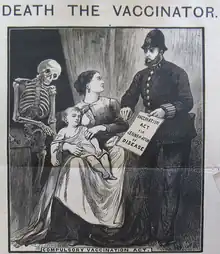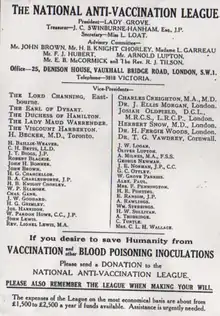National Anti-Vaccination League

The National Anti-Vaccination League (NAVL) was a British anti-vaccination organization that was formed in 1896 from earlier smaller organizations. Historically, the League had opposed compulsory vaccination, particularly against smallpox. It was part of a wider anti-vaccinationist movement, arguing that vaccination did more harm than good.
History
Anti-Compulsory Vaccination League
The National Anti-Vaccination League grew from earlier smaller organizations in London, originally under the title Anti-Compulsory Vaccination League (ACVL) in response to the government making smallpox vaccination compulsory. The Anti-Compulsory Vaccination League was founded by Richard Butler Gibbs at Finsbury in 1866.[1] Members included Richard's brother George Sleight Gibbs and his cousin John Gibbs, author of the first anti-vaccination pamphlet. The Anti-Compulsory Vaccination League had 103 branch leagues and claimed 10,000 members in 1871.[1]
In June 1867, the publication "Human Nature" campaigned against "The Vaccination Humbug".[2] It reported that many petitions had been presented to Parliament against Compulsory Vaccination, and many from parents who alleged that their children had died through the operation, and complained that these petitions had not been made public. The journal reported the formation of the Anti-Compulsory Vaccination League "To overthrow this huge piece of physiological absurdity and medical tyranny, and quoted Richard Gibbs, who ran the Free Hospital at the same address as stating "I believe we have hundreds of cases here, from being poisoned with vaccination, I deem incurable. One member of a family dating syphilitic symptoms from the time of vaccination, when all the other members of the family have been clear. We strongly advise parents to go to prison, rather than submit to have their helpless offspring inoculated with scrofula, syphilis, and mania."[2]
Notable members of the Anti-Compulsory Vaccination League were James Burns, George Dornbusch and Charles Thomas Pearce.[3]
After the death of Richard B. Gibbs in 1871, the Anti-Compulsory Vaccination League underwent various changes until 1876 when it was revived under the leadership of Mary Hume-Rothery and the Rev. W. Hume-Rothery.[4] The Anti-Compulsory Vaccination League published the Occasional Circular which later merged into the National Anti-Compulsory Vaccination Reporter.[5]
London Society for the Abolition of Compulsory Vaccination
In 1880, William Tebb enlarged and reorganized the League with the formation of the London Society for the Abolition of Compulsory Vaccination, with William Young as secretary.[5] The Vaccination Inquirer, established by Tebb in 1879, was adopted as the official organ of the Society.[5] A series of fourteen "Vaccination Tracts" was begun by Young in 1877 and completed by Garth Wilkinson in 1879. William White was the first editor of the Vaccination Inquirer and after his death in 1885, he was succeeded by Alfred Milnes.[5] Frances Hoggan and her husband authored an article for the Vaccination Inquirer in September 1883 which argued against compulsory vaccination.[6]
The London Society focused on lobbying parliamentary support in the 1880s and early 1890s.[5] They gained support from several members of the House of Commons of which the most prominent was Peter Alfred Taylor who was described as the "Mecca of antivaccination".[7]
National Anti-Vaccination League
The movement grew, and as the influence of the London Society overshadowed the Hume-Rotherys and it took the national lead,[4] it was decided in February 1896 to re-form the Society as The National Anti-Vaccination League.[5] Arthur Phelps was elected as President.[5] In 1898, the league took on a school leaver named Lily Loat. By 1909 she was elected as the league's Secretary.[8]
In 1906, George Bernard Shaw wrote a supportive letter to the National Anti-Vaccination League, equating methods of vaccination with "rubbing the contents of the dustpan into the wound".[9]
Lily Loat devoted her life to the cause and died still working for the league in 1958. The league's journal ceased to create new issues in 1972.[8]
Publications of The National Anti-Vaccination League

- 1901, An Italian Indictment of Vaccination., Carlo Ruata. Public address given at the opening of the session of the University of Perugia, November, 1898. Translated from the Italian. National Anti-Vaccination League: London.
- 1901, Vaccination a Delusion, Alfred Russel Wallace. Chapter 28 of The Wonderful Century
- 1902, Smallpox at Gloucester. A reply to Dr. Coupland's Report by Walter Hadwen. Reprinted from “The Reformer,” National Anti-Vaccination League: Gloucester
- 1902, Smallpox at Middlesbrough. A reply to Dr. Dingle's Reports ... 2nd edition, rev. by Biggs, John Thomas pp. 24.
- 1902, What about Vaccination, Milnes, Alfred. With other contributions. (When Doctors Disagree. The Wreck of the Preussen. Vaccination an Error.) National Anti-Vaccination League: Westminster.
- 1904, The Story of the Vaccination Crusade in Hackney & Stoke Newington, 1902–1904, and what came of it. The cases of John Polley, William Pitt, and others, with an account of the action-at-law Polley v. Fordham., Burton, John Francis. Hackney Union Branch of the National Anti-Vaccination League: London.
- 1910, For and Against Vaccination A statement by the Royal College of Physicians, Ireland; (with correspondence thereon, between A. Phelps and T. Percy C. Kirkpatrick).
- 1911, Smallpox and vaccination in British India.
- 1912, Leicester: Sanitation Versus Vaccination, J. T. Biggs, JP. Book.
- 1921, Vaccination and the State, Arnold Lupton MP.
- 1929, National Anti-Vaccination League (London) Thirty-third [etc.] Annual Report, etc.
- 1936, The Case Against Vaccination, Maurice Beddow Bayly.
- 1939, The Schick Inoculation Against Diphtheria, Maurice Beddow Bayly
- 1947, Smallpox and Vaccination., Trolridge, Arthur.
- 1952, B.C.G. Vaccination, Maurice Beddow Bayly.
- 1957, Is Mass Vaccination with B.C.G. always warranted in the Scandinavian Countries? (booklet).
References
- 1 2 Durbach, Nadja. (2005). Bodily Matters: The Anti-Vaccination Movement in England, 1853–1907. Duke University Press. p. 38. ISBN 978-0-8223-3423-1
- 1 2 "Philip Hoare: When you play virtual war games, spare a thought for the real veterans". The Independent. 2003-04-20. Retrieved 2020-09-13.
- ↑ Barrow, Logie. (2016). Independent Spirits Spiritualism and English Plebeians, 1850–1910. Routledge. pp. 186–187. ISBN 978-1-138-66565-1
- 1 2 "Rothery, Mary Catherine Hume (1824–1885), campaigner for medical reform and author". Oxford Dictionary of National Biography (online ed.). Oxford University Press. 2004. doi:10.1093/ref:odnb/49483. ISBN 978-0-19-861412-8. Retrieved 2020-05-28. (Subscription or UK public library membership required.)
- 1 2 3 4 5 6 7 Porter, Dorothy; Porter, Roy (1988). "The Politics of Prevention: Anti-Vaccinationism and Public Health in Nineteenth-Century England". Medical History. 32 (3): 231–252. doi:10.1017/s0025727300048225. PMC 1139881. PMID 3063903.
{{cite journal}}: CS1 maint: multiple names: authors list (link) - ↑ "Frances Hoggan MD 1843-1927". Breconshire Local & Family History Society (BLFHS) Cymdeithas Hanes Lleol a Theuluoedd Brycheiniog Newsletter 70 – October 2017.
- ↑ "Antivaccination Propaganda: The Bane And Its Antidote". The British Medical Journal. 2 (2166): 50–52. 1902. doi:10.1136/bmj.2.2166.50. S2CID 32125316.
- 1 2 Kramer, Molly Baer (2004). "Loat, Lily (1879/80–1958), anti-vaccination activist". Oxford Dictionary of National Biography (online ed.). Oxford University Press. doi:10.1093/ref:odnb/50749. ISBN 978-0-19-861412-8. Retrieved 2020-09-13. (Subscription or UK public library membership required.)
- ↑ Yang, Jennifer. (2014). "Contemporary debates on vaccination policies have historical parallels in Ransom Center’s collections". Ransom Center Magazine. Retrieved 20 June 2021.